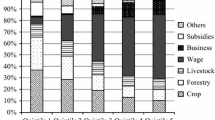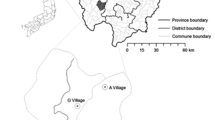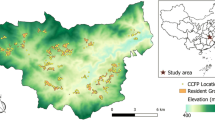Abstract
The Sloping Land Conversion Program (SLCP) is an important part of the Chinese ‘Priority Forestry Programs’ which has special effects on mountainous areas, ecologically and economically. This study was carried out in the Wuling mountainous area in Hunan Province of China. Based on data collected in a household survey of a sample of 375 households, a quantile regression model, Tobit regression model and weighted least square model were used to analyze the influence of participating in the SLCP on farmers’ sources of income (especially the poorest farmers), and the influence of forest type in SLCP land on farmers’ incomes. It was found that: (1) participating in the SLCP reduced farmers’ crop production income, but increased their forest income and subsidies; (2) participating in the SLCP increased farmers’ total income on average by 11.7 % and that of the poorest farmers by 24.7 %; and (3) choosing economic forest in the SLCP land increased farmers’ forest income, although its influence on total income was not statistically significant. These findings indicate that the SLCP has a positive effect on poverty alleviation in the Wuling mountainous area in the short run. However, the poverty alleviation effect is still unclear in the long run because the effect of the SLCP on changing farmers’ income structures is not obvious by observation, the subsidy term will have expired in 5 or 8 years and the forest revenue from the SLCP is low.


Similar content being viewed by others
Notes
The Forestry Law (2009) of the People’s Republic of China divides forests into five categories: timber forest (or commercial forest), economic forest, protection forest, fuelwood forest, and forest for special purposes. Timber forests mainly concern the cultivation and harvest of wood or bamboo. Economic forests—which are common in China—mainly produce fruit, edible oil materials, industrial raw materials, medicinal materials, and other forest products except wood, as in the cases of chestnut forests, jujube forests, walnut groves and tea-oil forests.
The estimated coefficients in the Tobit model cannot be explained as the marginal effect of the corresponding independent variable. When x i is a continuous variable, taking the partial derivative of \(E[y_{i} \left| {x_{i} } \right.] = \Phi (x_{i}^{'} \beta /\sigma )x_{i}^{'} \beta + \sigma \Phi (x_{i}^{'} \beta /\sigma )\), with respect to x i estimates the marginal effect as \(\beta \Phi (x_{i}^{'} \beta /\sigma )\); when x i is a dummy variable, the difference between x i = 1 and x i = 0 in E[y i |x i ] is the marginal effect.
According to the household survey, annual timber forest income per capita is 150.59 yuan on average in the study area, which accounts for 0.32 % of household’s total income per capita.
According to the Chinese Forest Act, based on the principle that timber consumption must be lower than its incremental growth, the government has strictly controlled the annual forest-harvesting quota. The total amount of national forest harvesting quota during the 11th 5-year plan (2005–2010) was 248.2 million m3 (bamboo-harvesting quota excluded).
According to the household survey, the subsidies of the first period in the study area was 1950 yuan per hectare, and hence 975 yuan per hectare in the second period.
References
Barua A, Katyaini S, Mili B et al (2014) Climate change and poverty: building resilience of rural mountain communities in South Sikkim, Eastern HimalayaIndia. Reg Environ Change 14(1):267–280
Chen G (2008) The development situation of mountainous areas in China and the development strategies in the future. Chin Natl Acad Sci 6:485–491 (in Chinese)
Feng Z, Yang Y, Zhang Y et al (2005) Grain-for-green policy and its impacts on grain supply in West China. Land Use Policy 22(4):301–312
Fitzenberger B, Koenker R, Machado JAF (2002) Economic applications of quantile regression. Physica-Verlag, Heidelberg
Guo X, Gan T, Li S et al (2005) SLCP: problems, causes, and policy design: A track case study of 100 households in Tian Quan county, Sichuan province. China Rural Surv 3:72–77 (Chinese version)
Hao L, Naiman D (2007) Quantile regression. Sage, London
Heckman JJ (1979) Sample selection bias as a specification error. Econometrica 47(1):153–161
Hu X (2005) Changes in the Rural Economic Structure after SLCP: A Case study of South Mountainous Area in Ningxia Province. Chin Agric Econ 5:63–74 (Chinese version)
Jiang H (2003) Sustainability of the micro investment incentives and policy. Chin Agric Econ 8:30–35 (Chinise version)
Koenker R, Bassett JG (1978) Regression quantiles. Econometrica 46(1):33–50
Li H, Yao S, Guo Y (2011) The analysis of the effects of SLCP on households’ economic behavior: A case study in Wuqi county. Chin Agric Econ 10:37–44 (Chinese version)
Lin Y, Yao S (2014) Impact of the sloping land conversion program on rural household income: an integrated estimation. Land Use Policy 40:56–63
Linders GJ, De Groot HLF (2006) Estimation of the gravity equation in the presence of zero flows. Tinbergen Institute Discussion Paper
Liu C, Liu H (2012) Priority forestry program and poverty alleviation. For Econ 1:73–76 (Chinese version)
Liu C, Zhang W (2006) The effect of SLCP on household’ income: A case study of the Beijing–Tianjin Sandstorm—Control Program. Economics 6(1):273–289 (Chinese version)
Liu C, Mullan K, Liu H et al (2014) The estimation of long term impacts of China’s key priority forestry programs on rural household incomes. J For Econ 20(3):267–285
SFA (State Forestry Administration) (2007) 2006 China forestry development report. China Forestry Press, Beijing (Chinese version)
Tobin J (1958) Estimation of relationships for limited dependent variables. Econometrica 26(1):24–36
Uchida Emi, Xu JT et al (2007) Are the Poor benefiting from China’s land conservation program? Environ Dev Econ 12(4):593–620
Wang XH, Bennett J (2008) Policy analysis of the conversion of cropland to forest and grassland program in China. Environ Econ Policy Stud 9(2):119–143
Wang C, Virginia M (2012) Evaluation of economic and social impacts of the sloping land conversion program: a case study in Dunhua county China. For Policy Econ 14(1):50–57
Wang GY, Innes JL, Lei JF et al (2007) China’s forestry reforms. Science 318(5856):1556–1557
Weyerhaeuser H, Wilkes A, Kahrl F (2005) Local impacts and responses to regional forest conservation and rehabilitation programs in China’s northwest Yunnan province. Agric Syst 85(3):234–253
Wooldridge JM (2012) Introductory econometrics: A modern approach. Cengage Learning, Boston
World Bank (2012) China 2030 building a modern, harmonious, and creative high-income society. World Bank, Washington
Wu Z (2007) Chinese mountainous industrial structure adjustment under the guidance of sustainable development. Fujian Normal University, Fuzhou (Chinese version)
Xu JT, Qin P (2004) Case studies of the socioeconomic influence of the converting cropland to forest and grassland program and the nature forest protection program. China Forestry Publishing House, Beijing (Chinese version)
Xu JT, Tao R, Xu ZG (2004) An empirical analysis of the cost effectiveness, structural adjustment, and long-term sustainability of the farmland conversion program in three western provinces. Econ Res Q 4:139–162 (Chinese version)
Xu ZG, Xu JT, Deng XZ et al (2006) Grain for green versus grain: conflict between food security and conservation set-aside in China. World Dev 34(1):130–148
Yi FJ, Xu JT, Xu ZG (2006) Economic impacts of SLCP. Chin Agric Econ 10:28–34
Yin RS, Xu JT, Li Z et al (2005) China’s ecological rehabilitation: the unprecedented efforts and dramatic impacts of reforestation and slope protection in western China. China Environ Ser 6:17–32
Yin RS, Yin G, Li L (2010) Assessing China’s ecological restoration programs: what’s been done and what remains to be done? Environ Manage 45:442–453
Zhu P (2006) Coordination of Stakeholders’ interests between the development of mountainous areas in Fujian. J Fujian Normal Univ Soc Sci 6:48–53 (Chinese version)
Zhu S, Zhang S, Tao W et al (2005) The analysis of influential factors of household’ reclaim decision in SLCP. China Popul Res Environ 15(5):108–115 (Chinese version)
Acknowledgments
For their constructive suggestions and help in this research, we are grateful to: Professor Bruce Manley, University of Canterbury in New Zealand; Mr. Boen M. Purnama, an advisor to the Indonesian Forest Concessioners Association (APHI); and Mr. Jacob Hendrik Kuper, the Director of the Royal Forest Estate Het Loo of the Netherlands. This research was supported by the Natural Science Foundation of China (71373024) and Social Science Project of China (11&ZD042).
Author information
Authors and Affiliations
Corresponding author
Appendices
Appendix 1: The Problem of Heteroscedasticity
In the linear regression model y = Xβ + ɛ, the Gauss–Markov assumption can be stated as E(ɛ|X.) = E(ɛ) = 0 and Cov(ɛ|X.) = E(ɛɛ ′) = σ 2 I N . If heteroscedasticity exists, the residual ɛ i values will have differing variances with regard to different values of i, and thus violate the Gauss–Markov assumption. Although heteroscedasticity cannot lead to estimation bias or inconformity of β j , the OLS estimator is not valid: the variances of the OLS estimator are no longer minimal, and the variable t test is meaningless. When the model confirms the existence of heteroscedasticity, weighted least squares (WLS) can be used to estimate the model (Wooldridge 2012). The new model is as follows:
where W i is the weight to reduce the heteroscedasticity. The new model satisfies the assumption of homoscedasticity, and so the estimator is unbiased and efficient.
Appendix 2: Merit of Choosing the Quantile Regression Model
Least squares estimation only estimates conditional means of y given x (Heckman 1979). For all conditional distributions of y given x, variances, skewness and kurtosis are assumed to be identical. However, the conditional distribution of y can be skewed or fat-tailed. Despite such restrictive and naive assumptions, most applied econometric analyses are concerned with conditional means (Fitzenberger et al. 2002). The quantile regression approach overcomes this limitation of the location shift model by allowing for various forms of the loss function that allow for potential scale shifts. In this study, the distribution of dependent variables shows a heavy tail (Fig. 3), hence estimates of the mean value through the use of OLS are misleading. Although this study took the logarithm of total household income, the assumption of normality still could not be satisfied.
Another advantage of quantile regression evident in is that quantile regression can provide a more nuanced view of the stochastic relationship between variables, and therefore, a more informative empirical analysis (Koenker and Bassett 1978). Different coefficient estimates at different quantiles would be a manifestation that an Ordinary Least Square model is inadequate to explain the underlying relationship between the variables of interest. In reality, policy-makers care more about the state of the poorest households compared to those of median-income households, and so this study adopts the quantile regression model to estimate the coefficients in various percentiles of y. The quantile regression model is:
Unlike in the linear regression model, \(\hat{y}_{Q}\) in this model indicates the estimates of the Q-quantile position (0 < Q < 1) of y under the condition of given x. The estimation method is the weighted least absolute estimation (WLA), which minimizes \(\sum {\left| {\hat{y}_{iQ} - a_{Q} - b_{Q} x_{i} } \right|h_{iQ} }\), here:
The initial value uses the estimates derived through use of the WLA method (Hao and Naiman 2007).
Appendix 3: Merit of Choosing the Tobit Model
The dependent variables in this study—including forest income, crop production income and nonfarm work income—can all take observed values of zero, which is known as censoring data. Consequently, the use of ordinary least squares (OLS) estimation can result in bias errors. A solution to the problem with censoring at zero was first proposed by Tobin (1958) as the censored regression model, which became known as Tobit model. Another way to solve this problem is treating the censored data as a sample selection process, using the selection equation of the two-stage estimation to correct the sample selection bias, and then estimating the regression model (Heckman 1979).
Endogenous selection bias may occur when SLCP participants are not assigned randomly, for instance, when household participation decisions are determined by some unobservable factors. However, in this study, households in assigned areas had the right to choose whether to participate in the program. The right is generally protected by SLCP regulations which have been implemented since 2002 (Feng et al. 2005). Besides, Linders et al. (2006) demonstrated through the Monte Carlo method that the Heckman selection model was more suitable for handling the problem of dependent variable having a large sum of zero observed data, which is not the case in this study. Thus this study treats participants as being assigned randomly, and adopts the Tobit method to estimate the model (D, E, F, J). The Tobit model is expressed as follows:
The latent variable y* satisfies the classical linear model assumptions; in particular, it has a normal, homoskedastic distribution with a linear conditional mean. When y* ≥ 0, the observed variable y equals y*, and where y* < 0, y = 0. x is matrix of explanatory variables, β are coefficients, and u is the residual error, which follows the standard normal distribution (Wooldridge 2012).
Rights and permissions
About this article
Cite this article
Duan, W., Lang, Z. & Wen, Y. The Effects of the Sloping Land Conversion Program on Poverty Alleviation in the Wuling Mountainous Area of China. Small-scale Forestry 14, 331–350 (2015). https://doi.org/10.1007/s11842-015-9291-0
Accepted:
Published:
Issue Date:
DOI: https://doi.org/10.1007/s11842-015-9291-0





